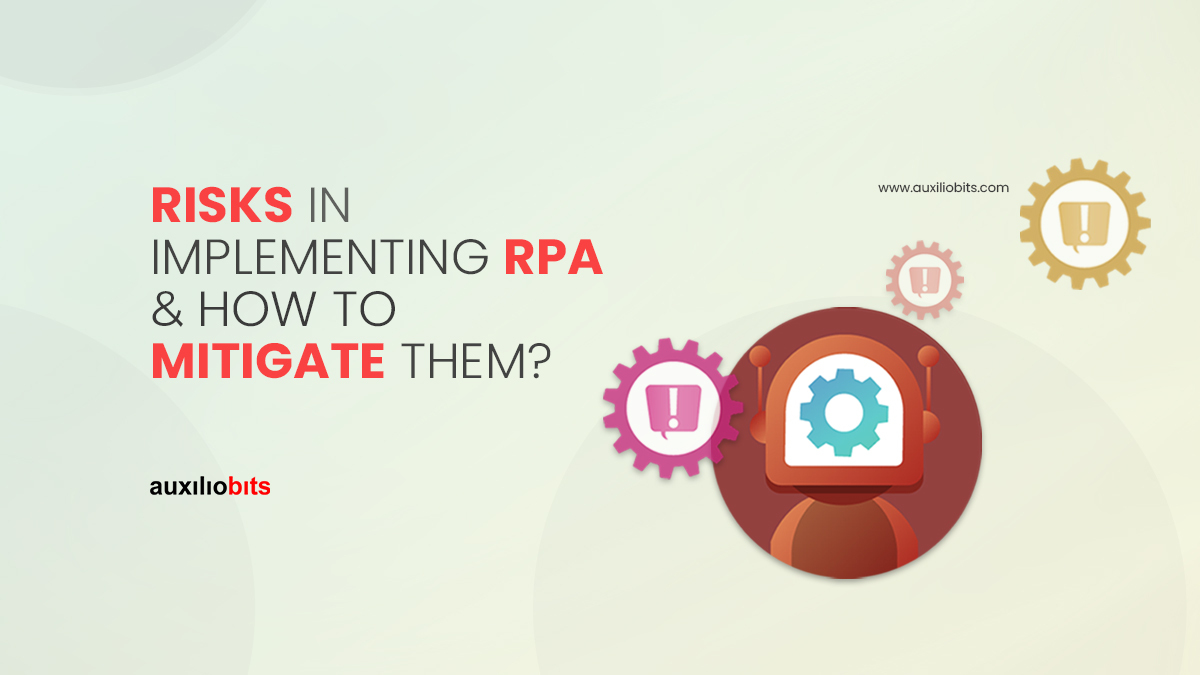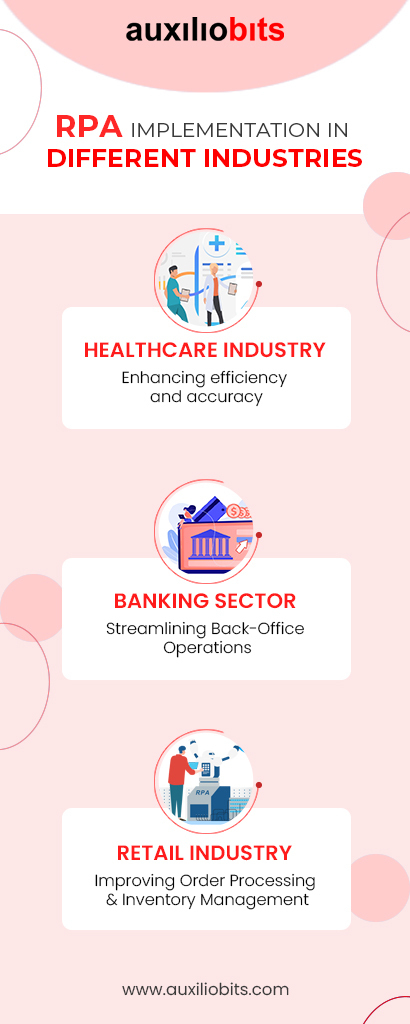
Key takeways
- Robotic Process Automation (RPA) offers numerous benefits, including increased productivity, reduced errors, cost savings & improved customer experience. However, RPA implementation comes with inherent risks and challenges.
- Common risks in RPA implementation include lack of proper planning, employee resistance, insufficient training, compatibility and integration challenges. Data security and privacy issues of concern.
- To mitigate these risks, organizations should prioritize comprehensive planning and strategy development, effective change management and employee engagement.They also need to organize adequate training and skill development programs, thorough compatibility testing and integration planning alongside robust data security measures.
- By addressing these challenges, organizations can successfully harness the potential of RPA to transform their processes and achieve digital excellence in their respective industries.
Just imagine a world where mundane tasks are handled seamlessly by intelligent software robots, allowing your workforce to focus on what truly matters – innovation, growth, and exceptional customer experiences. Exciting, right? So, welcome to this era of Robotic Process Automation (RPA), where the potential for revolutionizing business operations knows no bounds. But as with any journey into unfamiliar territory, there are risks & challenges to be faced. Here, we will explore the hidden dangers lurking in RPA implementation and arm you with battle-tested strategies to mitigate them effectively. Let’s dive in!
What Is RPA?
RPA (Robotic Process Automation) is a technology that utilizes software robots or “bots” to automate rule-based, repetitive tasks. These bots mimic human actions and interact with various software applications, performing tasks such as data entry, data extraction, report generation, and more. The key components of an RPA system include bots, a centralized control center, and integration tools, all working harmoniously to automate complex business processes with remarkable speed and accuracy.
Benefits of RPA Implementation
Increased Productivity And Efficiency
With RPA taking care of repetitive and time-consuming tasks, your human workforce is liberated to focus on higher-value activities. According to industry reports, RPA can deliver a remarkable 25-50% increase in savings & productivity, leading to significant time savings and resource optimization. (Source: Kofax)
Reduction In Errors And Improved Accuracy
manual processes, but RPA eliminates them with its unparalleled precision. Implementing RPA can reduce process errors to 0%, ensuring consistent and accurate execution of tasks. (Source: UiPath Forum)
Cost Savings And ROI Potential
Cost efficiency is a key driver of RPA adoption. By automating repetitive tasks, organizations can achieve substantial cost savings. Studies have shown that RPA implementation can lead to cost reductions ranging from 25% to 50%, contributing to an impressive return on investment. (Source: LinkedIn)
Enhanced Customer Experience
In today’s competitive landscape, customer experience reigns supreme. RPA plays a vital role in streamlining processes and improving service delivery. Organizations that leverage RPA witness a significant boost in customer satisfaction and loyalty. A study by Forrester Consulting revealed that implementing RPA resulted in a 57% improvement in customer service & experience metrics. (Source: UiPath)
Common Risks In RPA Implementation
Lack Of Proper Planning
Thorough planning and assessment are essential for a smooth RPA implementation. Inadequate planning can lead to various risks and potential consequences, such as ineffective automation and overlooked dependencies. Insufficient understanding of existing processes may result in automating the wrong tasks or automating processes that are not suitable for RPA. According to a survey by Deloitte, 43% of RPA implementation challenges stem from inadequate process analysis and planning. (Source: Deloitte)
Resistance From Employees
Employee resistance is a common challenge when introducing any new technology, including RPA. They may perceive automation as a threat to their job security, leading to resistance or reluctance to adopt RPA. According to a study by PwC, 60% of workers worry that automation will put their jobs/work at risk. (Source: Economic Times). Insufficient knowledge about RPA and its benefits can create resistance and hinder acceptance among employees.
Insufficient Training And Skill Gaps
To fully leverage the potential of RPA, organizations must invest in training and upskilling their employees. Without proper training, employees may struggle to effectively collaborate with RPA systems, leading to suboptimal outcomes and underutilization of automation capabilities. According to PWC, 74% of the workforce is learning new skills or re-training to remain employable in the future. (Source: PWC)
Compatibility And Integration Challenges
Integrating RPA with existing systems and applications can present compatibility challenges and risks. Incompatibility issues can disrupt existing workflows and cause delays or errors in process execution. According to research, 80% of healthcare organizations use legacy systems that don’t receive support from their manufacturers, and legacy systems used by the US government cost over $300 million annually to maintain. (Source: Aimultiple). And, inadequate integration can lead to data discrepancies or duplication, impacting data integrity and decision-making.
Data Security And Privacy Concerns
As organizations implement RPA, data security, and privacy become critical considerations. RPA involves the processing and transfer of sensitive data. Inadequate security measures can expose critical data to unauthorized access, leading to data breaches or compliance violations. Organizations must adhere to data protection rules/regulations such as GDPR (General Data Protection Regulation) & CCPA (California Consumer Privacy Act). Non-compliance can result in severe legal & financial consequences.

Mitigation Strategies For RPA Risks
Comprehensive Planning And Strategy Development
To mitigate risks stemming from inadequate planning, organizations should prioritize comprehensive planning and strategy development. Develop a roadmap that outlines the objectives, timelines, milestones, and dependencies for RPA implementation. In a study conducted by HFS Research on 100 health plans, it was found that 60% of the participants identified noteworthy chances for improvement across the entire health plan value chain and organizations with a well-defined implementation of the plans experienced faster time-to-value compared to those without. (Source: HFS Research)
Effective Change Management And Employee Engagement
To address resistance and promote acceptance, organizations must implement change management practices that facilitate a smooth transition. This includes clear communication about the benefits and objectives of RPA, addressing employee concerns, and providing a supportive environment for embracing change. Also, engage employees in the RPA journey by involving them in decision-making, seeking their input, and encouraging collaboration. Forbes surveyed 302 senior executives engaged in global implementations of Intelligent Automation and Robotic Process Automation. The survey revealed that 92 percent of the respondents reported enhanced employee satisfaction due to the implementation of these initiatives. (Source: Kofax)
Adequate Training And Skill Development Programs
To address skill gaps and ensure successful RPA implementation, organizations should develop comprehensive training programs that cover both theoretical knowledge and practical skills related to RPA tools and technologies. As per the research by UiPath, out of the respondents who have upgraded knowledge, 32% worked for organizations that provided technical training programs on robotic process automation (RPA) to upskill their workers which resulted in increased pay for the employees as well as higher rate of successful RPA implementation for organizations. (Source: UiPath)
Thorough Compatibility Testing And Integration Planning
Test the compatibility of RPA tools and systems with existing applications and infrastructure. This helps identify and address compatibility issues early on, minimizing disruptions during implementation. Additionally, create a comprehensive integration plan that outlines the steps, dependencies, and technical requirements for a successful deployment. Collaboration between IT and business teams is crucial to ensure alignment with existing systems and to address potential risks.
Robust Data Security Measures
Utilize encryption algorithms, access controls, and data loss prevention measures to secure sensitive data throughout the RPA lifecycle. Regularly update security protocols and technologies to stay ahead of potential threats. Conducting regular security audits and vulnerability assessments helps identify and address potential vulnerabilities. It ensures that security measures remain effective and up to date.
RPA Implementation Across Sectors
Healthcare Sector: Enhancing Efficiency And Accuracy
In the healthcare industry, RPA has proven to be a game-changer by enhancing efficiency and accuracy in various processes. By automating data entry and validation tasks, a healthcare organization was able to achieve significant time savings and minimize errors. In addition to time and accuracy improvements, RPA implementation in the healthcare sector has led to other key metrics and benefits. For example, a study conducted by Everest Group found that RPA implementation in eligibility checks and prior authorizations reduced processing time by 60% and decreased errors by 90%. (Source: LinkedIn)
Banking Sector: Streamlining Back-Office Operations
The banking sector has also witnessed significant improvements through RPA implementation, particularly in streamlining back-office operations. By leveraging RPA, a leading bank achieved remarkable results, including improving the total turnaround time by 70%, and enhancing process visibility by 80%. (Source: Nividous). RPA implementation in the banking sector also yielded substantial cost savings. Accenture mentioned that there are several articles explaining the potential cost savings when implementing RPA. Some studies say its cost reduction could be 75% in a certain sector, while others say it gets up to 80% or even 90%. (Source: Accenture)
Retail Industry: Improving Order Processing & Inventory Management
In the retail industry, RPA implementation has led to better inventory management and reduced costs. By automating inventory reconciliation, stock level monitoring, and demand forecasting, retailers have achieved notable reductions in overstock and out-of-stock situations. Research has shown that implementing RPA in inventory management can result in a reduction in delivery times and a decrease in excess inventory by 20% to 50%. (Source: LinkedIn). These improvements contribute to cost savings, optimized supply chain management, and improved overall business performance.

Conclusion
Robotic Process Automation (RPA) holds immense potential to revolutionize organizational processes in the era when digital transformation holds the key to success for businesses. However, it is crucial to acknowledge and address the risks associated with RPA implementation. While RPA implementation presents certain risks, organizations should embrace this transformative technology. By acknowledging these risks and implementing effective mitigation strategies, organizations can optimize processes, enhance productivity, and achieve cost savings. By doing so, organizations can thrive in the digital era, driving innovation & realizing the true potential of Robotic Process Automation.
If you want to ensure that you integrate RPA seamlessly into your systems by avoiding the associated risks, connect with the automation experts at Auxiliobits!
Stay Tuned for more articles about automation!





